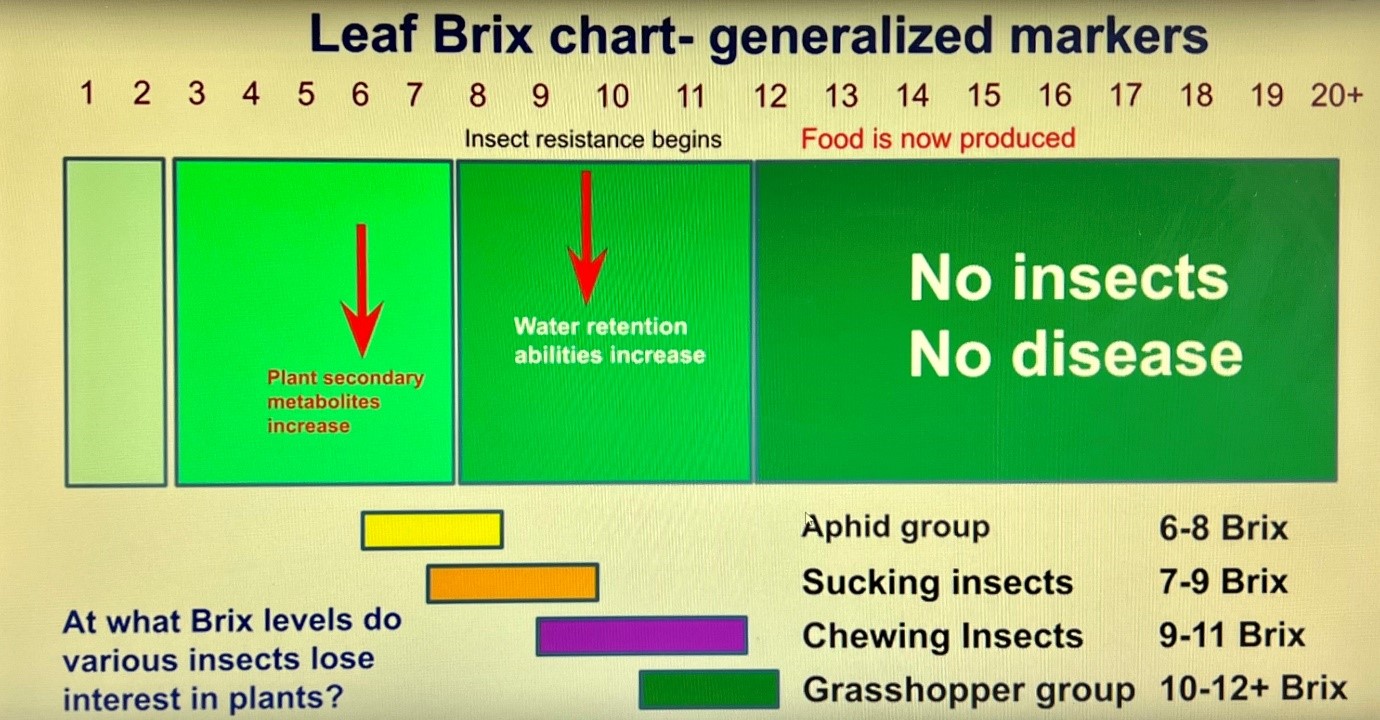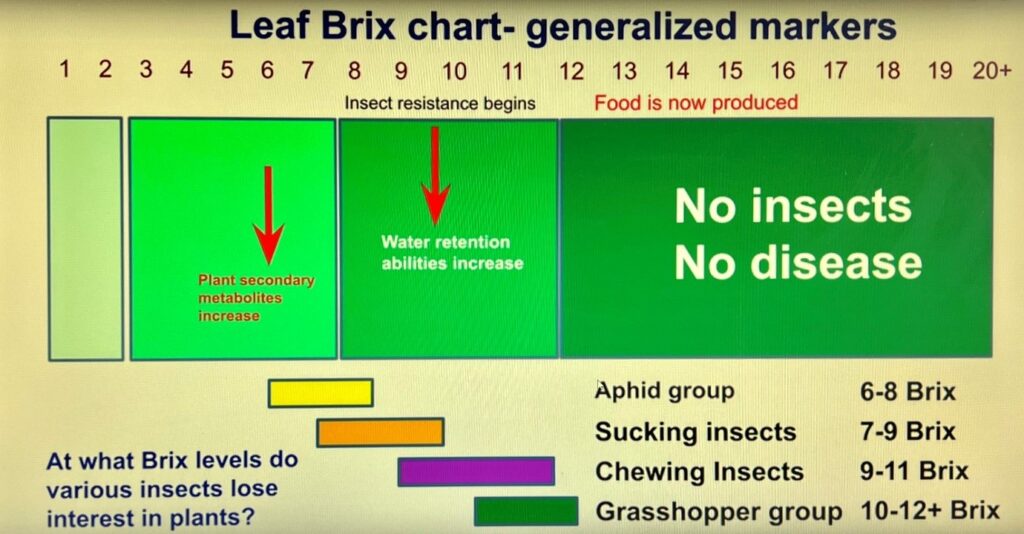What Lowers Leaf Brix Sugar Levels and How to Increase Them
Story at a Glance
- Latest thinking suggests insects don’t attack healthy plants with high Brix of over12% sugars.
- Plant health and Brix levels can be compromised by application of pesticides, high salt NPK fertilisers, GMO, no-till and greenhouse conditions.
- High Brix pushes about 50% of the sugar made in the leaves down to the roots to feed the microbes which take up minerals and nutrients in the soil.
- Without healthy microbes in the optimal root zone, heavy minerals can sink through the zone and be out of reach of the microbes.
- Different insect groups prefer different Brix levels. The grasshopper group prefer healthy plants with around 10-12 Brix levels.
- Aphids settle for unhealthy plants and start to lose interest with Brix over 6. You won’t see them when plants have Brix of 8 or more.
- Using foliar sprays will quickly increase Brix and reduce the total amount of fertiliser needed on your crop be it fruit or vegetables, trees or vines.
In our last blog we explored some of the latest thinking on why pests attack crops, be it fruit or vegetables, trees or vines. The thinking is that if your leaf Brix sugar levels are high enough (over 12%),insects are not attracted to the plant and will not attack it.
In this blog we’ll explore some of the reasons for low Brix and which insects like which Brix level.
What lowers Brix?
- Pesticides: such as Herbicides, Insecticides and Fungicides all kill specific microbes as well as the targets. If you use all three, reaching a high Brix is impossible as you kill off potentially all the microbes in the soil.Different herbicides kill different and specific microbes. If you rotate herbicides of different classes, you’ll kill off many more varieties of the microbe. Herbicides such as glyphosate also chelate or bind-up trace elements in the soil making them unavailable for plant nutrition and optimum health. Glyphosate also kills all vegetative material by interfering with the synthesis of essential amino acids that absorb UV radiation.So, while a soil test will show the elements as being in the soil profile, they won’t in fact be available. This is really important to understand.
- High salt fertilisers: High salt NPK actually stresses the plant (contrary to what I was taught years ago). We now know that force feeding the plant is akin to electrocuting the plant by raising the electrical conductivity (EC). NPKs can green up the plant as does iron but the plant can still be under stress and becomes dependent upon high salt NPK. But it is the micronutrients we need to focus on for optimum crop health.
- GMO Plants: These don’t exhibit high Brix. Many are at 5 or below and struggle to get to 10 but have a huge nutrient cost. I’ll use soybeans as an example but could have chosen GMO Round-up ready Canola. Soybeans have been extensively researched. GMO soy was introduced in 1996. Soybean aphid had been around for many years in really small numbers and would only eat the unhealthy beans. When GMO soybeans proliferated, aphids went to plague proportions and so much insecticide was/is required for control.
- Strict No-Till: In crops such as nuts, apples and citrus, the roots are shallow and cannot be tilled between the rows. When you use pesticides the excess falls to the ground and as we said before, the microbe population suffers. You cannot turn the ground over to allow microbes from a different soil layer to replace those killed by the pesticide. You just don’t have the microbes to hold the nutrients in the rootzone.
- Plants in Greenhouses: UV light or more correctly energy is fundamental to plant health. Enclosed in greenhouses without correct lighting there can be a UV deficiency. UV absorption is fundamental for sugar as well as amino acid /protein production and direction of growth. Plants always grow toward the light, the UV source, to get energy.
Brix, root microbes and plant health
Leaf Brix, microbe numbers and hence plant health are intertwined with nutrient dense high yielding crops. A high Brix plant pushes about 50% of the sugar made in the leaves (especially from the spur leaves) down to the roots to feed the microbes. If you have low Brix to start with and then compounded by any of the 5 Brix reducing scenarios above, you won’t have microbes – or not too many, at least.
Elements of carbon, hydrogen, oxygen, nitrogen and phosphorous are important for the skeletons or structure of the plant chemicals such as enzymes and proteins etc. Calcium is also extremely important at the right time, especially in the 14-day cell division period. Without calcium you simply cannot have a healthy plant.
Calcium is 20 times heavier than hydrogen. If microbes are not in the soil in the optimum root zone, (see #1 and #5 above) to hold calcium and other minerals such as manganese, iron, cobalt, nickel, copper, zinc, etc, the minerals will sink out of this optimal zone. They will fall down under gravity and not be available to the plant.
How to increase crop nutrient density and reduce costs
High Brix is so important to plant health and high yielding nutrient dense fruit, vegetables and of course nuts. So how can we replace nutrients efficiently to keep Brix at optimum levels? We’re all suffering from the escalation of fertiliser costs, especially dry powder and granular products.
Using foliar fertiliser sprays will quickly increase Brix and reduce the total amount of fertiliser needed on your crop be it fruit or vegetables, trees or vines. Foliar sprays are more efficient than soil applied fertilisers in that the nutrients go straight into the leaf and are used immediately. There is no competition between the trace elements as there can be with soil applied trace elements.
Chelated trace elements in the foliar fertiliser ensure that there is no antagonism or competition with each other and go to work immediately within the leaf chemistry. On the other hand, soil applied nutrients need microbial action to convert them to a suitable structure for root uptake. This can take time to achieve and is also dependent upon microbe concentration in the soil.
What leaf Brix level do insects prefer?

Grasshopper group: 10-12 Brix. Higher than 12 the leaves are difficult to chew, are indigestible and the hoppers loose interest. If Brix is too low the leaf is too unhealthy even for them to survive so they have little interest.
Other chewing insects: They leave the plant when the Brix gets between 9-11 whether in the roots, stem, leaf or flower. They can tolerate a higher Brix but lose that over 11. In the middle of feeding if you can get the Brix up over 12, they’ll lose interest. While they will stay on the leaf, we observe they won’t eat it and will actually starve. They can chew on any part of the plant and at any life stage while Brix is lowish.
Sucking Insects: These will lose interest in the plant when the leaf Brix is between 7-9. They will always be on the plant with Brix lower than 9 but to attack the plant Brix needs to be less than 7.
Aphid and scale: They start to lose interest with Brix over 6. Totally gone at 8. Calcium is the aphid’s enemy. Young leaves have less calcium than say spur leaves and the aphids go after them. The change in calcium changes the taste. There is also a change in ammonium levels but that’s for another day.
Now is fruit filling season. We have a lot more to go through and so until next time get cracking and check your leaf Brix if you are not already doing it.
Fertilising is uncomplicated with Kendon High K foliar fertiliser.
